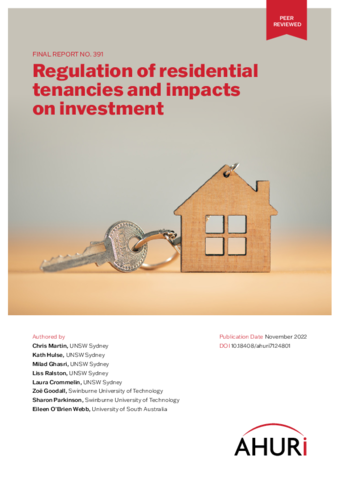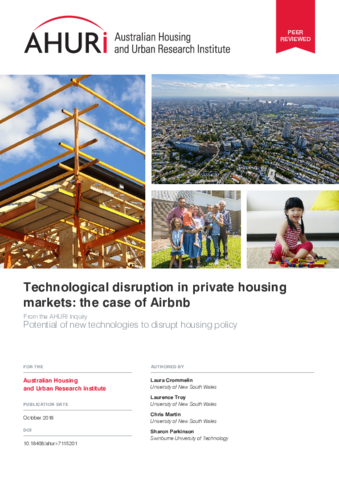
Understanding what is a ‘rent freeze’, a ‘rent cap’ or ‘rent control’
27 Jun 2023
With rental housing being unaffordable for so many tenants, policy option discussions have raised the possibilities of imposing rent controls. In this AHURI Brief we look at what those options might mean, some of the research into their outcomes and how these might be enacted in Australia.
What is a rent freeze?
During a legislated ‘rent freeze’ landlords are not able to increase rents for current tenants and, depending on legislation, may also mean landlords can’t increase rents for new tenants. ‘Rent freeze’ legislation needs to ensure that tenants can’t be simply evicted and replaced with tenants who can pay higher rents. A rent freeze is usually applied for a specified restricted time (e.g. for two years).
What is a rent cap?
A ‘rent cap’ can incorporate options that restrict how often rents can be increased, how much they can be increased or be a combination of both frequency and value of increase.
The cap on the rate of increase can be a specific value (i.e. can only increase by $X per week); be a specific proportion of the rent (i.e. increase by X% of current rent); or be referenced to an external economic measurement such the consumer price index (CPI).
A rent cap can also restrict the number of times rent can be increased each year; usually once a year, but in some jurisdictions landlords can raise the rent twice a year.
While not strictly speaking a rent cap, the ACT is the only Australian jurisdiction to include an objective ‘guideline’ in its excessive rent increase provisions. This guideline means that, where a rent increase would be more than 110 per cent of the increase in the rent component of the ACT Consumer Price Index over the relevant period, the landlord needs to apply to the ACT Civil & Administrative Tribunal (ACAT) to demonstrate that the increase is not excessive, in relation to prevailing market rents for comparable premises.
Other terms used in restricting rents
Other terms common in legislation used in restricting rents (particularly internationally) include rent control and rent stabilisation. It’s important to note that both these terms have no legal definition in Australia.
What is Rent control?
The most commonly quoted legislated occurrence of rent control occurs in New York (USA) for apartments in buildings built before February 1947. The legislation allows landlords to raise the rent by up to 7.5 percent each year up to a ceiling rent determined by a rent control board. These apartments are only available to the original tenants (as of the passing of the legislation) or to their heir. However, once the original tenant or their heir dies or moves out, the apartment reverts to become a rent stabilised apartment (if in a building with 6 or more apartments) or to the unregulated private rental market.
What is Rent stabilisation?
Rent stabilisation is another legislated term used in New York (USA). Apartments in buildings with six or more apartments, that were built between February 1, 1947 and January 1, 1974 can be covered by rent stabilisation laws. While the benefits to tenants are not as large as in rent controlled apartments, rent stabilised tenants enjoy ‘limits on annual rent increases (determined annually by the Rent Guidelines Board) and a guaranteed right to renew.’ In New York (in 2017), 45 per cent of tenant households lived in rent stabilised dwellings (946,514 households); 1 per cent (21,751 households) lived in rent controlled dwellings; 42 per cent (879,995 households) lived in unregulated private rental sector dwellings; and 9 per cent (184,729 households) lived in public housing (with 3% in other forms of rental housing).
Does rent control/stabilisation work to deliver affordable housing?
There is a growing body of research on the effects of rent control. Much of the research is econometric, and takes advantage of ‘natural experiments’: that is, it examines changes in housing market data when rent controls are introduced or lifted in particular locations. As such, it usually deals with specific rent control regimes. Because there are many different ways of regulating rents, care needs to be taken in generalising from the results of research.
Research from the USA in 2018 suggests that rent control or rent stabilisation that keeps rents below market rates has a number of consequences, in that:
- it can reduce number of rental properties as landlords sell to owner occupants so that they can earn the market price for their real estate
- it can lead to ‘mis-match’ between tenants and rental units. Once a tenant has secured a rent-controlled apartment, they may choose not to move in the future and give up rent control, even if their housing needs change, which can lead to an inefficient allocation of housing resources
- renters may choose to consume excessive quantities of housing
- it can lead to disrepair of the rental housing stock as landlords may not invest in maintenance because they can’t recoup their investment by raising rents.
Rent control and stabilisation can benefit tenants by preventing excessive rent increases, which potentially limits tenants having to move away from local communities that they value, such as a network of friends and family, proximity to a job, or children enrolled in local schools.
In addition, unless strict legal restrictions are put on the use of properties, it could also encourage landlords to take dwellings off the long-term private rental market (where rents are controlled) and instead make those properties only available on short-term letting (STL) platforms such as AirBnB. AHURI research has identified that STL does reduce ‘the availability of rental properties in high-demand inner city areas with significant tourism appeal’ of Australian cities, removing an estimated 15 per cent of long-term rental housing stock in some areas.
The Brookings studies showed that when rent stabilisations were removed from properties previously subject to rent control (in Cambridge, Massachusetts, USA), landlords began to charge market rents and the value of those properties increased by 45 per cent. Neighbouring properties also increased their value as a result, ‘suggesting that the effect of rent control had been to reduce the whole neighbourhood’s desirability’ and that ‘the policy imposed $2.0 billion in costs to local property owners, but only $300 million of that cost was transferred to renters in rent-controlled apartments.’
The lifting of rent stabilisation on some specific types of dwellings in San Francisco (USA) revealed that the beneficiaries of rent control are 19 percent less likely move to a new address. However, in practice landlords could evict tenants for a number of practical reasons (such as moving in themselves or converting/building condominiums for sale).
As a result, ‘rent-controlled buildings were 8 percentage points more likely to convert to a condo than buildings in the control group’ and that ‘rent control led to a 15 percentage point decline in the number of renters living in treated buildings and a 25 percentage point reduction in the number of renters living in rent-controlled units, relative to 1994 levels. This large reduction in rental housing supply was driven by converting existing structures to owner-occupied condominium housing and by replacing existing structures with new construction’ usually for the higher priced end of the market.
[A condominium, or condo, is an individually owned unit in a larger building containing many units, and roughly equates to strata-titled apartment ownership—whether for owner occupiers or for renting in the private rental market—in the Australian housing system.]
The US research states that an unfortunate outcome was that ‘rent control has actually contributed to the gentrification of San Francisco, the exact opposite of the policy’s intended goal.’
Ultimately the research found that (in the USA) ‘rent control appears to help affordability in the short run for current tenants, but in the long-run decreases affordability, fuels gentrification and creates negative externalities on the surrounding neighbourhood.’
What laws cover rent increases in Australia?
It is relevant to note that, in Australia, rental regulations are legislated through (and are the responsibility of) state and territory rental tenancy laws. Indeed, the Australian Constitution (under Part V – Powers of the Parliament. 51.) doesn’t give the Commonwealth Government legislative powers in relation to private rental markets.
Australian states and territories only lightly regulate rents. No jurisdiction regulates the amount of rent a landlord may seek when letting a property, nor limit the size of an increase, except by providing that a tenant may dispute a notified rent increase as ‘excessive’.
In the ACT, for example, rent increases are resolved through the ACT Civil & Administrative Tribunal (ACAT). The law that applies to rental property disputes (including rent increases) is the Residential Tenancies Act 1997; ACAT resolves and decides disputes under this Act.
Similar regulation and tribunals exists in each of the other states and territories. There is no equivalent federal legislation, the nearest equivalent national tribunal is the Administrative Appeals Tribunal—for this body to address property disputes would likely require a significant change in operational scope.
This brief has been updated to clarify ACT measures as well as the current research available.


